Understanding Uterine Fibroid Management
VerifiedAdded on 2020/03/04
|9
|2675
|52
AI Summary
This assignment delves into the management of symptomatic uterine fibroids. It examines different treatment options available, such as surgical procedures (myomectomy, hysterectomy), uterine artery embolization, and medication use. The document also discusses postoperative complications associated with these treatments and highlights the importance of patient-centered care in decision-making. Furthermore, it touches upon the impact of specialty values on treatment choices.
Contribute Materials
Your contribution can guide someone’s learning journey. Share your
documents today.

Running head: NURSING
Nursing
Name of the student:
Name of the university:
Author note:
Nursing
Name of the student:
Name of the university:
Author note:
Secure Best Marks with AI Grader
Need help grading? Try our AI Grader for instant feedback on your assignments.

1NURSING
This assignment is about Janet Jackson, a 40 year old woman experiencing the
symptoms of uterine fibroids and has been admitted to the hospital, for a vaginal
hysterectomy via spinal anaesthesia. She was being supported with the urinary catheter as she
had been given a spinal anaesthesia.
Uterine fibroids are a kind of non carcinogenic developments of the uterus that
regularly shows up during the teenage. They are also called leiomyomas (lie-o-my-O-muhs)
or myomas. Uterine fibroids are not related to expanded risk of disease of uterus and never
cause malignant growth (Vilos et al., 2015). Fibroids can grow in a very scarce amount
which is invisible to the human vision, to huge amount that can increase and enlarge the
uterus. A woman can have solitary fibroid or fibroids in groups. In severe cases, different
fibroids can grow so much that the uterus reaches up to the rib cage (Khan, Shehmar, &
Gupta, 2014).
Most of the women suffering from uterine fibroids don’t show any symptoms. The
woman who reflects the symptoms can be changed with respect to location, size and number.
The uterine fibroids have some common symptoms include:
i. Heavy flow of menstrual blood
ii. Bleeding that lasts for more than a week
iii. Pelvic pressure or pain
iv. Frequent tendency to urinate
v. Difficulty in urinating
vi. Constipation
vii. Backache or leg pains
A fibroid may cause severe pain when it increases its blood supply and starts
collapsing. They are generally classified according to the location. Uterine fibroids are a
This assignment is about Janet Jackson, a 40 year old woman experiencing the
symptoms of uterine fibroids and has been admitted to the hospital, for a vaginal
hysterectomy via spinal anaesthesia. She was being supported with the urinary catheter as she
had been given a spinal anaesthesia.
Uterine fibroids are a kind of non carcinogenic developments of the uterus that
regularly shows up during the teenage. They are also called leiomyomas (lie-o-my-O-muhs)
or myomas. Uterine fibroids are not related to expanded risk of disease of uterus and never
cause malignant growth (Vilos et al., 2015). Fibroids can grow in a very scarce amount
which is invisible to the human vision, to huge amount that can increase and enlarge the
uterus. A woman can have solitary fibroid or fibroids in groups. In severe cases, different
fibroids can grow so much that the uterus reaches up to the rib cage (Khan, Shehmar, &
Gupta, 2014).
Most of the women suffering from uterine fibroids don’t show any symptoms. The
woman who reflects the symptoms can be changed with respect to location, size and number.
The uterine fibroids have some common symptoms include:
i. Heavy flow of menstrual blood
ii. Bleeding that lasts for more than a week
iii. Pelvic pressure or pain
iv. Frequent tendency to urinate
v. Difficulty in urinating
vi. Constipation
vii. Backache or leg pains
A fibroid may cause severe pain when it increases its blood supply and starts
collapsing. They are generally classified according to the location. Uterine fibroids are a
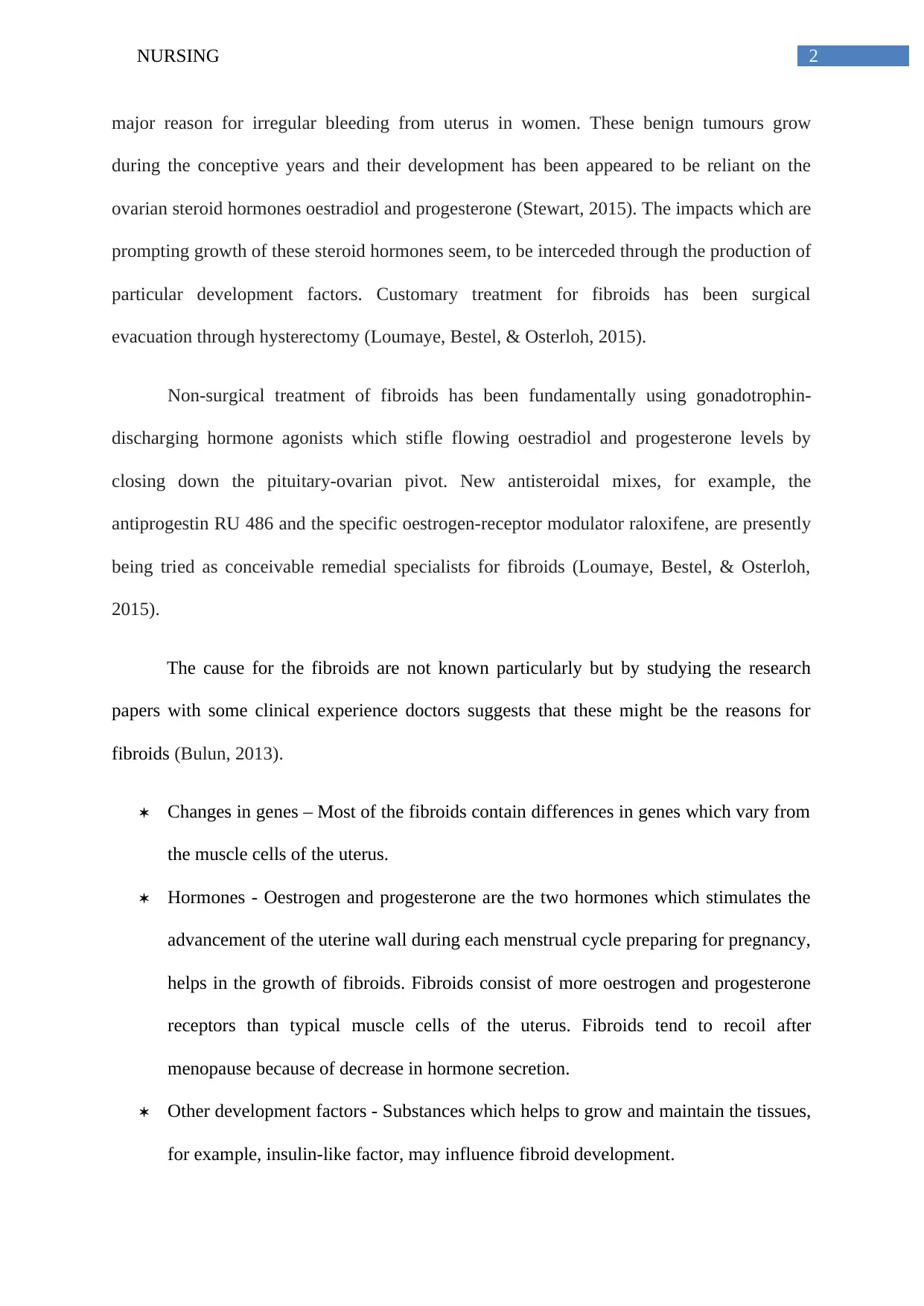
2NURSING
major reason for irregular bleeding from uterus in women. These benign tumours grow
during the conceptive years and their development has been appeared to be reliant on the
ovarian steroid hormones oestradiol and progesterone (Stewart, 2015). The impacts which are
prompting growth of these steroid hormones seem, to be interceded through the production of
particular development factors. Customary treatment for fibroids has been surgical
evacuation through hysterectomy (Loumaye, Bestel, & Osterloh, 2015).
Non-surgical treatment of fibroids has been fundamentally using gonadotrophin-
discharging hormone agonists which stifle flowing oestradiol and progesterone levels by
closing down the pituitary-ovarian pivot. New antisteroidal mixes, for example, the
antiprogestin RU 486 and the specific oestrogen-receptor modulator raloxifene, are presently
being tried as conceivable remedial specialists for fibroids (Loumaye, Bestel, & Osterloh,
2015).
The cause for the fibroids are not known particularly but by studying the research
papers with some clinical experience doctors suggests that these might be the reasons for
fibroids (Bulun, 2013).
Changes in genes – Most of the fibroids contain differences in genes which vary from
the muscle cells of the uterus.
Hormones - Oestrogen and progesterone are the two hormones which stimulates the
advancement of the uterine wall during each menstrual cycle preparing for pregnancy,
helps in the growth of fibroids. Fibroids consist of more oestrogen and progesterone
receptors than typical muscle cells of the uterus. Fibroids tend to recoil after
menopause because of decrease in hormone secretion.
Other development factors - Substances which helps to grow and maintain the tissues,
for example, insulin-like factor, may influence fibroid development.
major reason for irregular bleeding from uterus in women. These benign tumours grow
during the conceptive years and their development has been appeared to be reliant on the
ovarian steroid hormones oestradiol and progesterone (Stewart, 2015). The impacts which are
prompting growth of these steroid hormones seem, to be interceded through the production of
particular development factors. Customary treatment for fibroids has been surgical
evacuation through hysterectomy (Loumaye, Bestel, & Osterloh, 2015).
Non-surgical treatment of fibroids has been fundamentally using gonadotrophin-
discharging hormone agonists which stifle flowing oestradiol and progesterone levels by
closing down the pituitary-ovarian pivot. New antisteroidal mixes, for example, the
antiprogestin RU 486 and the specific oestrogen-receptor modulator raloxifene, are presently
being tried as conceivable remedial specialists for fibroids (Loumaye, Bestel, & Osterloh,
2015).
The cause for the fibroids are not known particularly but by studying the research
papers with some clinical experience doctors suggests that these might be the reasons for
fibroids (Bulun, 2013).
Changes in genes – Most of the fibroids contain differences in genes which vary from
the muscle cells of the uterus.
Hormones - Oestrogen and progesterone are the two hormones which stimulates the
advancement of the uterine wall during each menstrual cycle preparing for pregnancy,
helps in the growth of fibroids. Fibroids consist of more oestrogen and progesterone
receptors than typical muscle cells of the uterus. Fibroids tend to recoil after
menopause because of decrease in hormone secretion.
Other development factors - Substances which helps to grow and maintain the tissues,
for example, insulin-like factor, may influence fibroid development.
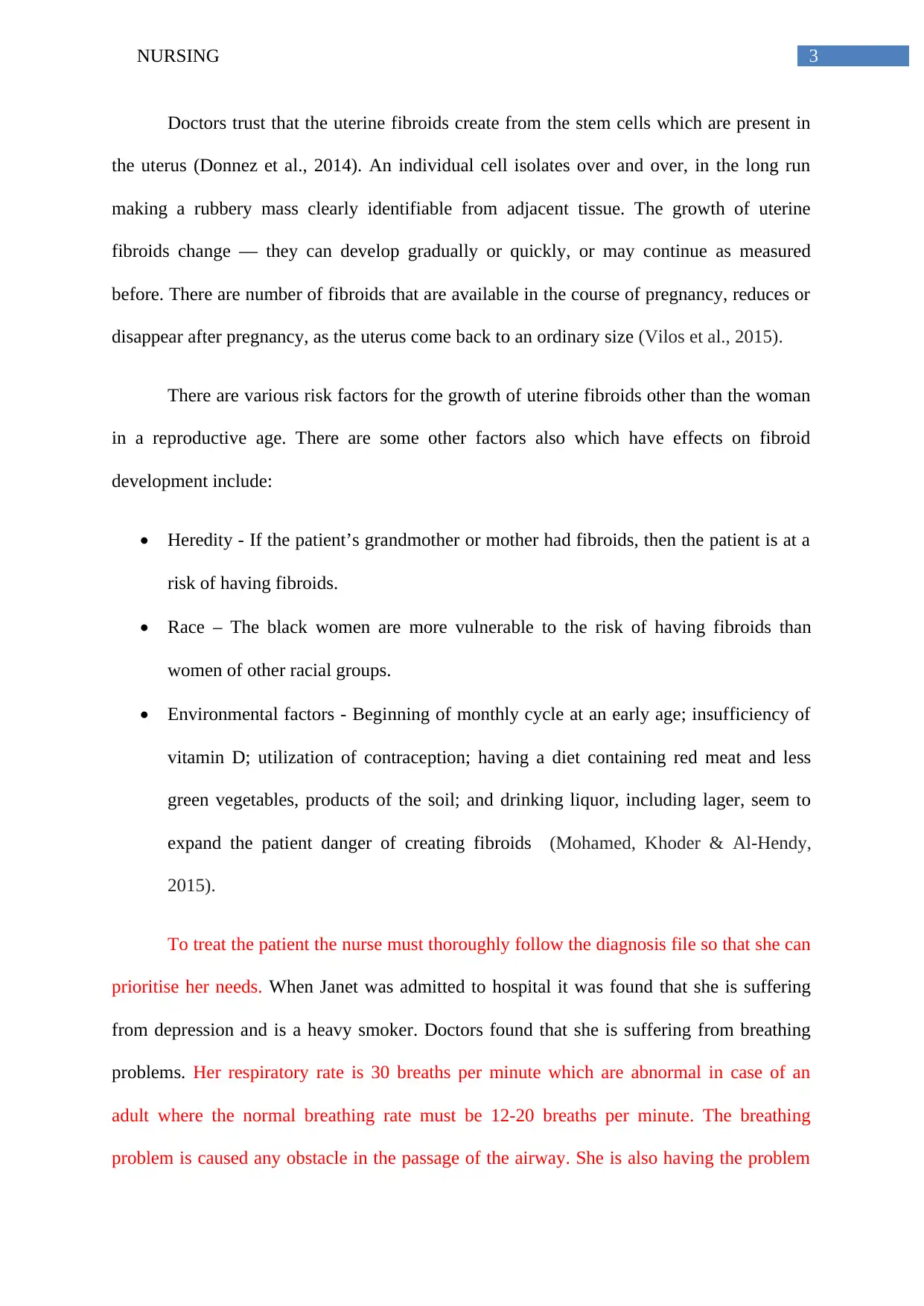
3NURSING
Doctors trust that the uterine fibroids create from the stem cells which are present in
the uterus (Donnez et al., 2014). An individual cell isolates over and over, in the long run
making a rubbery mass clearly identifiable from adjacent tissue. The growth of uterine
fibroids change — they can develop gradually or quickly, or may continue as measured
before. There are number of fibroids that are available in the course of pregnancy, reduces or
disappear after pregnancy, as the uterus come back to an ordinary size (Vilos et al., 2015).
There are various risk factors for the growth of uterine fibroids other than the woman
in a reproductive age. There are some other factors also which have effects on fibroid
development include:
• Heredity - If the patient’s grandmother or mother had fibroids, then the patient is at a
risk of having fibroids.
• Race – The black women are more vulnerable to the risk of having fibroids than
women of other racial groups.
• Environmental factors - Beginning of monthly cycle at an early age; insufficiency of
vitamin D; utilization of contraception; having a diet containing red meat and less
green vegetables, products of the soil; and drinking liquor, including lager, seem to
expand the patient danger of creating fibroids (Mohamed, Khoder & Al-Hendy,
2015).
To treat the patient the nurse must thoroughly follow the diagnosis file so that she can
prioritise her needs. When Janet was admitted to hospital it was found that she is suffering
from depression and is a heavy smoker. Doctors found that she is suffering from breathing
problems. Her respiratory rate is 30 breaths per minute which are abnormal in case of an
adult where the normal breathing rate must be 12-20 breaths per minute. The breathing
problem is caused any obstacle in the passage of the airway. She is also having the problem
Doctors trust that the uterine fibroids create from the stem cells which are present in
the uterus (Donnez et al., 2014). An individual cell isolates over and over, in the long run
making a rubbery mass clearly identifiable from adjacent tissue. The growth of uterine
fibroids change — they can develop gradually or quickly, or may continue as measured
before. There are number of fibroids that are available in the course of pregnancy, reduces or
disappear after pregnancy, as the uterus come back to an ordinary size (Vilos et al., 2015).
There are various risk factors for the growth of uterine fibroids other than the woman
in a reproductive age. There are some other factors also which have effects on fibroid
development include:
• Heredity - If the patient’s grandmother or mother had fibroids, then the patient is at a
risk of having fibroids.
• Race – The black women are more vulnerable to the risk of having fibroids than
women of other racial groups.
• Environmental factors - Beginning of monthly cycle at an early age; insufficiency of
vitamin D; utilization of contraception; having a diet containing red meat and less
green vegetables, products of the soil; and drinking liquor, including lager, seem to
expand the patient danger of creating fibroids (Mohamed, Khoder & Al-Hendy,
2015).
To treat the patient the nurse must thoroughly follow the diagnosis file so that she can
prioritise her needs. When Janet was admitted to hospital it was found that she is suffering
from depression and is a heavy smoker. Doctors found that she is suffering from breathing
problems. Her respiratory rate is 30 breaths per minute which are abnormal in case of an
adult where the normal breathing rate must be 12-20 breaths per minute. The breathing
problem is caused any obstacle in the passage of the airway. She is also having the problem
Secure Best Marks with AI Grader
Need help grading? Try our AI Grader for instant feedback on your assignments.
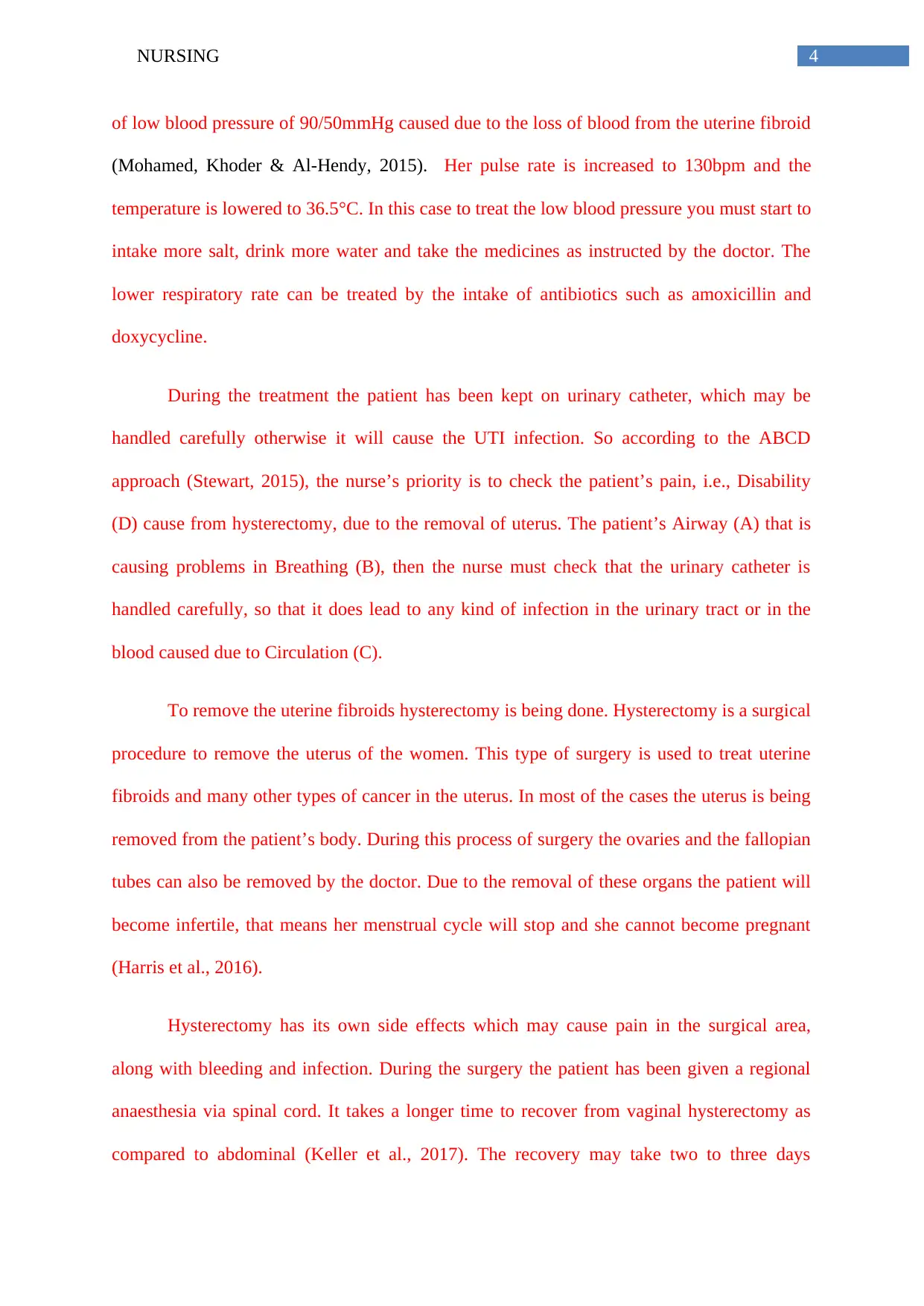
4NURSING
of low blood pressure of 90/50mmHg caused due to the loss of blood from the uterine fibroid
(Mohamed, Khoder & Al-Hendy, 2015). Her pulse rate is increased to 130bpm and the
temperature is lowered to 36.5°C. In this case to treat the low blood pressure you must start to
intake more salt, drink more water and take the medicines as instructed by the doctor. The
lower respiratory rate can be treated by the intake of antibiotics such as amoxicillin and
doxycycline.
During the treatment the patient has been kept on urinary catheter, which may be
handled carefully otherwise it will cause the UTI infection. So according to the ABCD
approach (Stewart, 2015), the nurse’s priority is to check the patient’s pain, i.e., Disability
(D) cause from hysterectomy, due to the removal of uterus. The patient’s Airway (A) that is
causing problems in Breathing (B), then the nurse must check that the urinary catheter is
handled carefully, so that it does lead to any kind of infection in the urinary tract or in the
blood caused due to Circulation (C).
To remove the uterine fibroids hysterectomy is being done. Hysterectomy is a surgical
procedure to remove the uterus of the women. This type of surgery is used to treat uterine
fibroids and many other types of cancer in the uterus. In most of the cases the uterus is being
removed from the patient’s body. During this process of surgery the ovaries and the fallopian
tubes can also be removed by the doctor. Due to the removal of these organs the patient will
become infertile, that means her menstrual cycle will stop and she cannot become pregnant
(Harris et al., 2016).
Hysterectomy has its own side effects which may cause pain in the surgical area,
along with bleeding and infection. During the surgery the patient has been given a regional
anaesthesia via spinal cord. It takes a longer time to recover from vaginal hysterectomy as
compared to abdominal (Keller et al., 2017). The recovery may take two to three days
of low blood pressure of 90/50mmHg caused due to the loss of blood from the uterine fibroid
(Mohamed, Khoder & Al-Hendy, 2015). Her pulse rate is increased to 130bpm and the
temperature is lowered to 36.5°C. In this case to treat the low blood pressure you must start to
intake more salt, drink more water and take the medicines as instructed by the doctor. The
lower respiratory rate can be treated by the intake of antibiotics such as amoxicillin and
doxycycline.
During the treatment the patient has been kept on urinary catheter, which may be
handled carefully otherwise it will cause the UTI infection. So according to the ABCD
approach (Stewart, 2015), the nurse’s priority is to check the patient’s pain, i.e., Disability
(D) cause from hysterectomy, due to the removal of uterus. The patient’s Airway (A) that is
causing problems in Breathing (B), then the nurse must check that the urinary catheter is
handled carefully, so that it does lead to any kind of infection in the urinary tract or in the
blood caused due to Circulation (C).
To remove the uterine fibroids hysterectomy is being done. Hysterectomy is a surgical
procedure to remove the uterus of the women. This type of surgery is used to treat uterine
fibroids and many other types of cancer in the uterus. In most of the cases the uterus is being
removed from the patient’s body. During this process of surgery the ovaries and the fallopian
tubes can also be removed by the doctor. Due to the removal of these organs the patient will
become infertile, that means her menstrual cycle will stop and she cannot become pregnant
(Harris et al., 2016).
Hysterectomy has its own side effects which may cause pain in the surgical area,
along with bleeding and infection. During the surgery the patient has been given a regional
anaesthesia via spinal cord. It takes a longer time to recover from vaginal hysterectomy as
compared to abdominal (Keller et al., 2017). The recovery may take two to three days
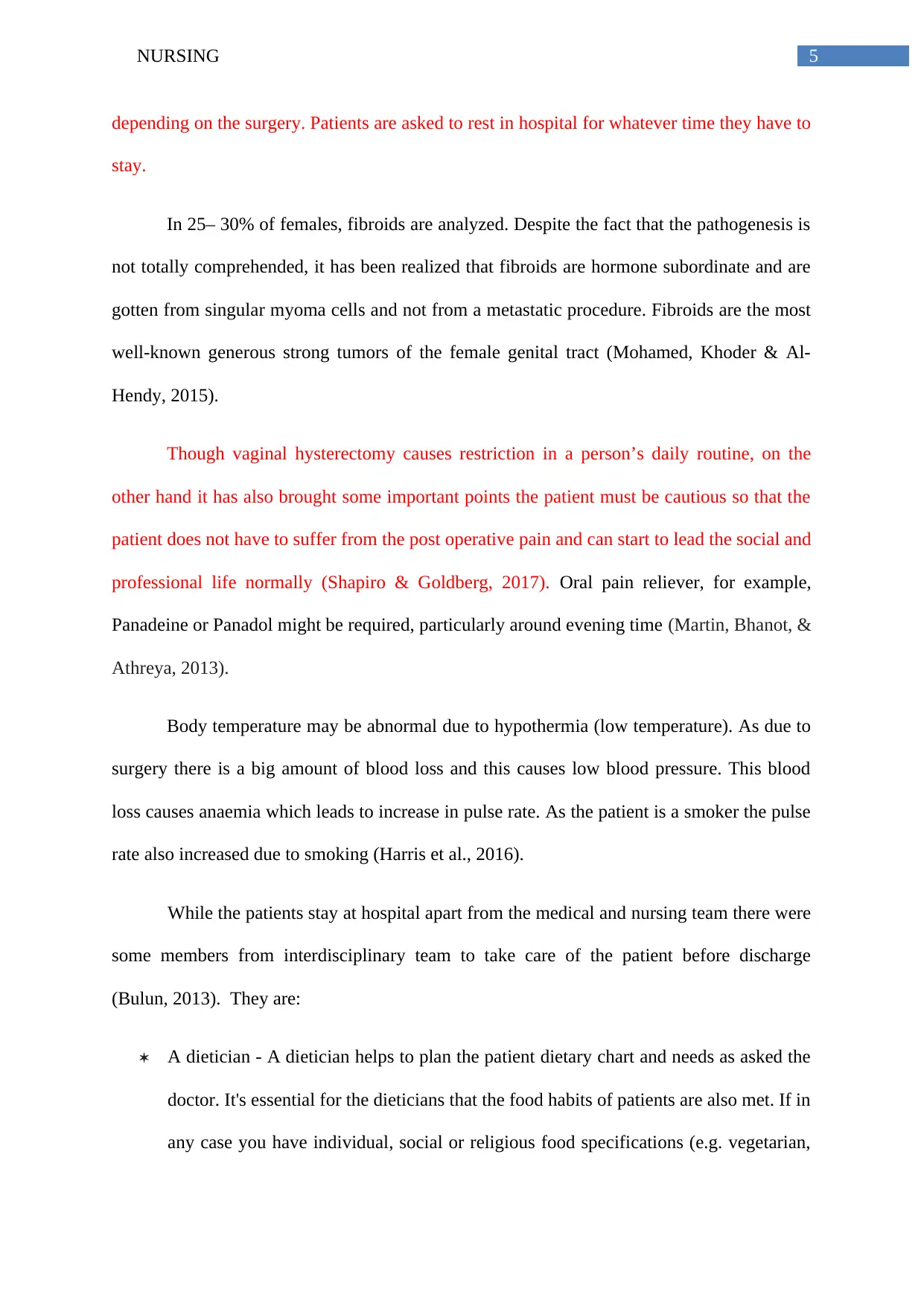
5NURSING
depending on the surgery. Patients are asked to rest in hospital for whatever time they have to
stay.
In 25– 30% of females, fibroids are analyzed. Despite the fact that the pathogenesis is
not totally comprehended, it has been realized that fibroids are hormone subordinate and are
gotten from singular myoma cells and not from a metastatic procedure. Fibroids are the most
well-known generous strong tumors of the female genital tract (Mohamed, Khoder & Al-
Hendy, 2015).
Though vaginal hysterectomy causes restriction in a person’s daily routine, on the
other hand it has also brought some important points the patient must be cautious so that the
patient does not have to suffer from the post operative pain and can start to lead the social and
professional life normally (Shapiro & Goldberg, 2017). Oral pain reliever, for example,
Panadeine or Panadol might be required, particularly around evening time (Martin, Bhanot, &
Athreya, 2013).
Body temperature may be abnormal due to hypothermia (low temperature). As due to
surgery there is a big amount of blood loss and this causes low blood pressure. This blood
loss causes anaemia which leads to increase in pulse rate. As the patient is a smoker the pulse
rate also increased due to smoking (Harris et al., 2016).
While the patients stay at hospital apart from the medical and nursing team there were
some members from interdisciplinary team to take care of the patient before discharge
(Bulun, 2013). They are:
A dietician - A dietician helps to plan the patient dietary chart and needs as asked the
doctor. It's essential for the dieticians that the food habits of patients are also met. If in
any case you have individual, social or religious food specifications (e.g. vegetarian,
depending on the surgery. Patients are asked to rest in hospital for whatever time they have to
stay.
In 25– 30% of females, fibroids are analyzed. Despite the fact that the pathogenesis is
not totally comprehended, it has been realized that fibroids are hormone subordinate and are
gotten from singular myoma cells and not from a metastatic procedure. Fibroids are the most
well-known generous strong tumors of the female genital tract (Mohamed, Khoder & Al-
Hendy, 2015).
Though vaginal hysterectomy causes restriction in a person’s daily routine, on the
other hand it has also brought some important points the patient must be cautious so that the
patient does not have to suffer from the post operative pain and can start to lead the social and
professional life normally (Shapiro & Goldberg, 2017). Oral pain reliever, for example,
Panadeine or Panadol might be required, particularly around evening time (Martin, Bhanot, &
Athreya, 2013).
Body temperature may be abnormal due to hypothermia (low temperature). As due to
surgery there is a big amount of blood loss and this causes low blood pressure. This blood
loss causes anaemia which leads to increase in pulse rate. As the patient is a smoker the pulse
rate also increased due to smoking (Harris et al., 2016).
While the patients stay at hospital apart from the medical and nursing team there were
some members from interdisciplinary team to take care of the patient before discharge
(Bulun, 2013). They are:
A dietician - A dietician helps to plan the patient dietary chart and needs as asked the
doctor. It's essential for the dieticians that the food habits of patients are also met. If in
any case you have individual, social or religious food specifications (e.g. vegetarian,
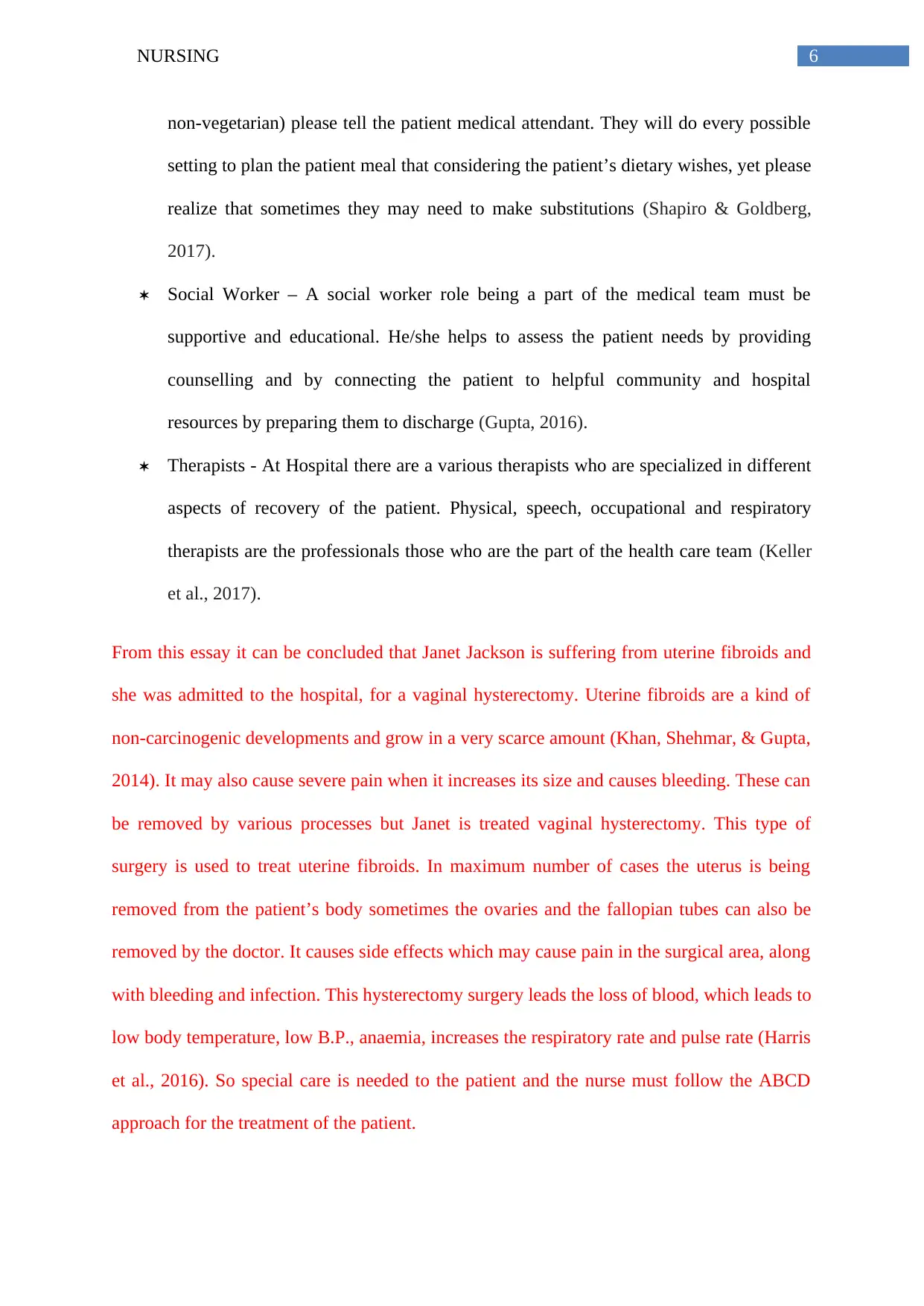
6NURSING
non-vegetarian) please tell the patient medical attendant. They will do every possible
setting to plan the patient meal that considering the patient’s dietary wishes, yet please
realize that sometimes they may need to make substitutions (Shapiro & Goldberg,
2017).
Social Worker – A social worker role being a part of the medical team must be
supportive and educational. He/she helps to assess the patient needs by providing
counselling and by connecting the patient to helpful community and hospital
resources by preparing them to discharge (Gupta, 2016).
Therapists - At Hospital there are a various therapists who are specialized in different
aspects of recovery of the patient. Physical, speech, occupational and respiratory
therapists are the professionals those who are the part of the health care team (Keller
et al., 2017).
From this essay it can be concluded that Janet Jackson is suffering from uterine fibroids and
she was admitted to the hospital, for a vaginal hysterectomy. Uterine fibroids are a kind of
non-carcinogenic developments and grow in a very scarce amount (Khan, Shehmar, & Gupta,
2014). It may also cause severe pain when it increases its size and causes bleeding. These can
be removed by various processes but Janet is treated vaginal hysterectomy. This type of
surgery is used to treat uterine fibroids. In maximum number of cases the uterus is being
removed from the patient’s body sometimes the ovaries and the fallopian tubes can also be
removed by the doctor. It causes side effects which may cause pain in the surgical area, along
with bleeding and infection. This hysterectomy surgery leads the loss of blood, which leads to
low body temperature, low B.P., anaemia, increases the respiratory rate and pulse rate (Harris
et al., 2016). So special care is needed to the patient and the nurse must follow the ABCD
approach for the treatment of the patient.
non-vegetarian) please tell the patient medical attendant. They will do every possible
setting to plan the patient meal that considering the patient’s dietary wishes, yet please
realize that sometimes they may need to make substitutions (Shapiro & Goldberg,
2017).
Social Worker – A social worker role being a part of the medical team must be
supportive and educational. He/she helps to assess the patient needs by providing
counselling and by connecting the patient to helpful community and hospital
resources by preparing them to discharge (Gupta, 2016).
Therapists - At Hospital there are a various therapists who are specialized in different
aspects of recovery of the patient. Physical, speech, occupational and respiratory
therapists are the professionals those who are the part of the health care team (Keller
et al., 2017).
From this essay it can be concluded that Janet Jackson is suffering from uterine fibroids and
she was admitted to the hospital, for a vaginal hysterectomy. Uterine fibroids are a kind of
non-carcinogenic developments and grow in a very scarce amount (Khan, Shehmar, & Gupta,
2014). It may also cause severe pain when it increases its size and causes bleeding. These can
be removed by various processes but Janet is treated vaginal hysterectomy. This type of
surgery is used to treat uterine fibroids. In maximum number of cases the uterus is being
removed from the patient’s body sometimes the ovaries and the fallopian tubes can also be
removed by the doctor. It causes side effects which may cause pain in the surgical area, along
with bleeding and infection. This hysterectomy surgery leads the loss of blood, which leads to
low body temperature, low B.P., anaemia, increases the respiratory rate and pulse rate (Harris
et al., 2016). So special care is needed to the patient and the nurse must follow the ABCD
approach for the treatment of the patient.
Paraphrase This Document
Need a fresh take? Get an instant paraphrase of this document with our AI Paraphraser
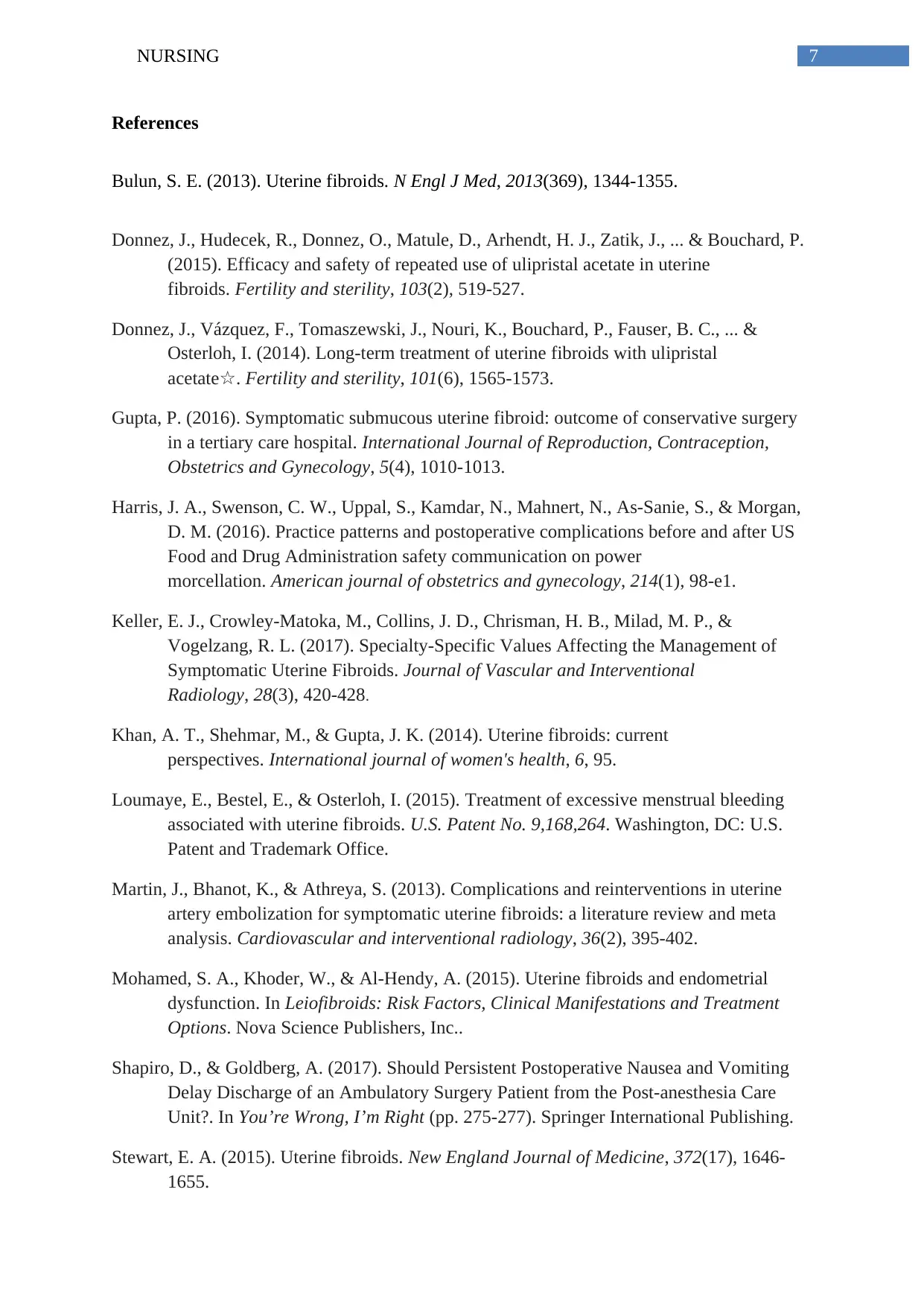
7NURSING
References
Bulun, S. E. (2013). Uterine fibroids. N Engl J Med, 2013(369), 1344-1355.
Donnez, J., Hudecek, R., Donnez, O., Matule, D., Arhendt, H. J., Zatik, J., ... & Bouchard, P.
(2015). Efficacy and safety of repeated use of ulipristal acetate in uterine
fibroids. Fertility and sterility, 103(2), 519-527.
Donnez, J., Vázquez, F., Tomaszewski, J., Nouri, K., Bouchard, P., Fauser, B. C., ... &
Osterloh, I. (2014). Long-term treatment of uterine fibroids with ulipristal
acetate☆. Fertility and sterility, 101(6), 1565-1573.
Gupta, P. (2016). Symptomatic submucous uterine fibroid: outcome of conservative surgery
in a tertiary care hospital. International Journal of Reproduction, Contraception,
Obstetrics and Gynecology, 5(4), 1010-1013.
Harris, J. A., Swenson, C. W., Uppal, S., Kamdar, N., Mahnert, N., As-Sanie, S., & Morgan,
D. M. (2016). Practice patterns and postoperative complications before and after US
Food and Drug Administration safety communication on power
morcellation. American journal of obstetrics and gynecology, 214(1), 98-e1.
Keller, E. J., Crowley-Matoka, M., Collins, J. D., Chrisman, H. B., Milad, M. P., &
Vogelzang, R. L. (2017). Specialty-Specific Values Affecting the Management of
Symptomatic Uterine Fibroids. Journal of Vascular and Interventional
Radiology, 28(3), 420-428.
Khan, A. T., Shehmar, M., & Gupta, J. K. (2014). Uterine fibroids: current
perspectives. International journal of women's health, 6, 95.
Loumaye, E., Bestel, E., & Osterloh, I. (2015). Treatment of excessive menstrual bleeding
associated with uterine fibroids. U.S. Patent No. 9,168,264. Washington, DC: U.S.
Patent and Trademark Office.
Martin, J., Bhanot, K., & Athreya, S. (2013). Complications and reinterventions in uterine
artery embolization for symptomatic uterine fibroids: a literature review and meta
analysis. Cardiovascular and interventional radiology, 36(2), 395-402.
Mohamed, S. A., Khoder, W., & Al-Hendy, A. (2015). Uterine fibroids and endometrial
dysfunction. In Leiofibroids: Risk Factors, Clinical Manifestations and Treatment
Options. Nova Science Publishers, Inc..
Shapiro, D., & Goldberg, A. (2017). Should Persistent Postoperative Nausea and Vomiting
Delay Discharge of an Ambulatory Surgery Patient from the Post-anesthesia Care
Unit?. In You’re Wrong, I’m Right (pp. 275-277). Springer International Publishing.
Stewart, E. A. (2015). Uterine fibroids. New England Journal of Medicine, 372(17), 1646-
1655.
References
Bulun, S. E. (2013). Uterine fibroids. N Engl J Med, 2013(369), 1344-1355.
Donnez, J., Hudecek, R., Donnez, O., Matule, D., Arhendt, H. J., Zatik, J., ... & Bouchard, P.
(2015). Efficacy and safety of repeated use of ulipristal acetate in uterine
fibroids. Fertility and sterility, 103(2), 519-527.
Donnez, J., Vázquez, F., Tomaszewski, J., Nouri, K., Bouchard, P., Fauser, B. C., ... &
Osterloh, I. (2014). Long-term treatment of uterine fibroids with ulipristal
acetate☆. Fertility and sterility, 101(6), 1565-1573.
Gupta, P. (2016). Symptomatic submucous uterine fibroid: outcome of conservative surgery
in a tertiary care hospital. International Journal of Reproduction, Contraception,
Obstetrics and Gynecology, 5(4), 1010-1013.
Harris, J. A., Swenson, C. W., Uppal, S., Kamdar, N., Mahnert, N., As-Sanie, S., & Morgan,
D. M. (2016). Practice patterns and postoperative complications before and after US
Food and Drug Administration safety communication on power
morcellation. American journal of obstetrics and gynecology, 214(1), 98-e1.
Keller, E. J., Crowley-Matoka, M., Collins, J. D., Chrisman, H. B., Milad, M. P., &
Vogelzang, R. L. (2017). Specialty-Specific Values Affecting the Management of
Symptomatic Uterine Fibroids. Journal of Vascular and Interventional
Radiology, 28(3), 420-428.
Khan, A. T., Shehmar, M., & Gupta, J. K. (2014). Uterine fibroids: current
perspectives. International journal of women's health, 6, 95.
Loumaye, E., Bestel, E., & Osterloh, I. (2015). Treatment of excessive menstrual bleeding
associated with uterine fibroids. U.S. Patent No. 9,168,264. Washington, DC: U.S.
Patent and Trademark Office.
Martin, J., Bhanot, K., & Athreya, S. (2013). Complications and reinterventions in uterine
artery embolization for symptomatic uterine fibroids: a literature review and meta
analysis. Cardiovascular and interventional radiology, 36(2), 395-402.
Mohamed, S. A., Khoder, W., & Al-Hendy, A. (2015). Uterine fibroids and endometrial
dysfunction. In Leiofibroids: Risk Factors, Clinical Manifestations and Treatment
Options. Nova Science Publishers, Inc..
Shapiro, D., & Goldberg, A. (2017). Should Persistent Postoperative Nausea and Vomiting
Delay Discharge of an Ambulatory Surgery Patient from the Post-anesthesia Care
Unit?. In You’re Wrong, I’m Right (pp. 275-277). Springer International Publishing.
Stewart, E. A. (2015). Uterine fibroids. New England Journal of Medicine, 372(17), 1646-
1655.

8NURSING
Vilos, G. A., Allaire, C., Laberge, P. Y., Leyland, N., Vilos, A. G., Murji, A., & Chen, I.
(2015). The management of uterine leiofibroids. Journal of Obstetrics and
Gynaecology Canada, 37(2), 157-178.
Vilos, G. A., Allaire, C., Laberge, P. Y., Leyland, N., Vilos, A. G., Murji, A., & Chen, I.
(2015). The management of uterine leiofibroids. Journal of Obstetrics and
Gynaecology Canada, 37(2), 157-178.
Vilos, G. A., Allaire, C., Laberge, P. Y., Leyland, N., Vilos, A. G., Murji, A., & Chen, I.
(2015). The management of uterine leiofibroids. Journal of Obstetrics and
Gynaecology Canada, 37(2), 157-178.
Vilos, G. A., Allaire, C., Laberge, P. Y., Leyland, N., Vilos, A. G., Murji, A., & Chen, I.
(2015). The management of uterine leiofibroids. Journal of Obstetrics and
Gynaecology Canada, 37(2), 157-178.
1 out of 9
Related Documents
Your All-in-One AI-Powered Toolkit for Academic Success.
+13062052269
info@desklib.com
Available 24*7 on WhatsApp / Email
![[object Object]](/_next/static/media/star-bottom.7253800d.svg)
Unlock your academic potential
© 2024 | Zucol Services PVT LTD | All rights reserved.





